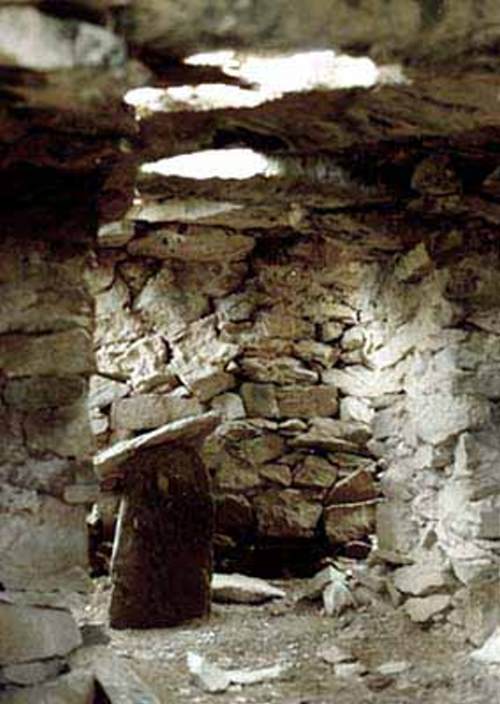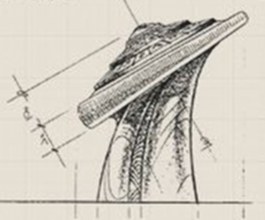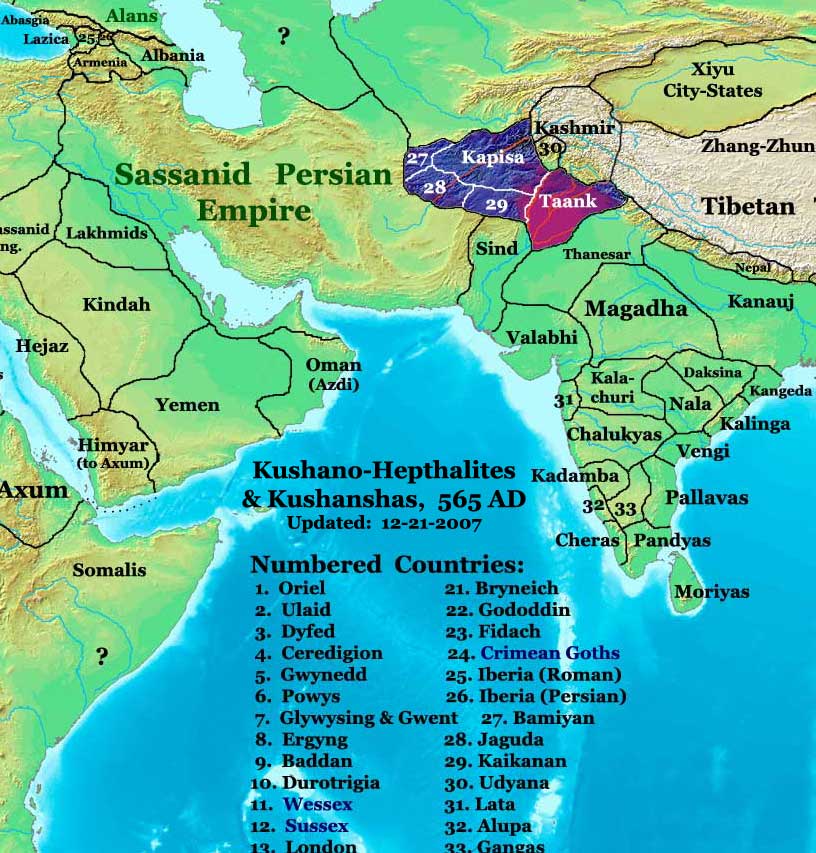Zhangzhung Kingdoms
..
Mount Kailash, Courtesy
chinawesttour.com
Zhang Zhung, Shang Shung, or Tibetan Pinyin Xang Xung,
was an ancient culture of western and northwestern
Tibet, which pre-dates
the culture of Tibetan Buddhism in Tibet. Zhang Zhung culture is associated
with the Bön religion, which in turn, has influenced the philosophies
and practices of Tibetan Buddhism. The Zhang Zhung are mentioned frequently
in ancient Tibetan texts as the original rulers of central and western
Tibet. Only in the last two decades have archaeologists been given access
to do archaeological work in the areas controlled by the Zhang Zhung.
Recently, a tentative match has been proposed between
the Zhang Zhung and an Iron Age culture now being uncovered on the Chang
Tang plateau of northwestern Tibet.
Extent of the Zhang Zhung Kingdoms
..
The Kushano-Hephthalite Kingdoms in 565 AD
According to Annals of Lake Manasarowar (Lake
Manasarovar), at one point the Zhang Zhung civilization consisted of 18
kingdoms in the west and northwest portion of Tibet. The Zhang Zhung culture
was centered around sacred Mount Kailash and extended west to Sarmatians
and present-day Ladakh & Baltistan, southwest to Jalandhar, south to
the Kingdom of Mustang in Nepal, east to include central Tibet, and north
across the vast Chang Tang plateau and the Taklamakan Desert to Shanshan.
Thus the Zhang Zhung culture controlled the major portion of the "roof
of the world".
Tradition has it that Zhang Zhung consisted "of three
different regions: sGob-ba, the outer; Phug-pa, the inner; and Bar-ba,
the middle. The outer is what we might call Western Tibet, from Gilgit
in the west to Dangs-ra khyung-rdzong in the east, next to lake gNam-mtsho,
and from Khotan in the north to Chu-mig brgyad-cu rtsa-gnyis in the south.
The inner region is said to be sTag-gzig (Tazig) [often identified with
Bactria], and the middle rGya-mkhar bar-chod, a place not yet identified."
While it is not certain whether Zhang Zhung was really so large, it is
known that it was an independent kingdom and covered the whole of Western
Tibet.[1][2]
The capital city of Zhang Zhung was called Khyunglung
(Khyunglung Ngülkhar or Khyung-lung dngul-mkhar), the "Silver Palace of
Garuda",
southwest of Mount Kailash (Mount Ti-se), which is identified with palaces
found in the upper Sutlej Valley.[3]
The Zhang Zhung built a towering fort, Chugtso Dropo,
on the shores of sacred Lake Dangra, from which they exerted military power
over the surrounding district in central Tibet.
The fact that some of the ancient texts describing
the Zhang Zhung kingdom also claimed the Sutlej valley was Shambhala, the
land of happiness (from which James Hilton possibly derived the name "Shangri
La"), may have delayed their study by Western scholars.
History of the Zhangzhung
Paleolithic findings
Pollen and tree ring analysis indicates the Chang Tang
plateau was a much more livable environment until becoming drier and colder
starting around 1500 BC. One theory is that the civilization established
itself on the plateau when conditions were less harsh, then managed to
persist against gradually worsening climatic conditions until finally expiring
around 1000 CE (the area is now used only by wandering nomads). This timeframe
also corresponds to the rise of the Tibetan kingdoms in the southern valleys
which may also have contributed to the decline of the plateau culture.
Iron Age culture of the Chang
Tang - the Zhang Zhung?
Recent archeological work on the Chang Tang plateau
finds evidence of an Iron Age culture which some have tentatively identified
as the Zhangzhung. This culture is notable for the following characteristics:
-
a system of hilltop stone forts or citadels, likely used
as a defense against the steppe tribes of Central Asia, such as the Scythians
-
burial complexes which use vertical tombstones, occasionally
in large arrays, and including up to 10,000 graves in one location
-
stone temples located in the mountains adjacent to the
plains, characterized by windowless rooms, corbelled stone roofs, and round
walls
-
evidence of a stratified social structure, as indicated
by royal or princely tombs
-
petroglyphs which shows the culture was a warrior horse
culture
These characteristics more closely match the Iron Age
cultures of Europe and the Asian steppes than those of India or East Asia,
suggesting a cultural influence which arrived from the west or north rather
than the east or south.
The Conquest of Zhangzhung
There is some confusion as to whether Central Tibet
conquered Zhangzhung during the reign of Songtsän
Gampo (605 or 617? - 649) or in the reign of Trisong Detsän (Wylie:
Khri-srong-lde-btsan), (r. 755 until 797 or 804 CE).[4]
The records of the Tang Annals do, however, seem to clearly place these
events in the reign of Songtsän Gampo for they say that in 634, Yangtong
(Zhang Zhung) and various
Qiang tribes "altogether submitted to him." Following
this he united with the country of Yangtong to defeat the 'Azha or Tuyuhun,
and then conquered two more tribes of Qiang before threatening Songzhou
with an army of more than 200,000 men. He then sent an envoy with gifts
of gold and silk to the Chinese emperor to ask for a Chinese princess in
marriage and, when refused, attacked Songzhou. He apparently finally retreated
and apologised and later the emperor granted his request.[5][6]
Early Tibetan accounts say that the Tibetan king and
the king of Zhangzhung had married each other's sisters in a political
alliance. However, the Tibetan wife of the king of the Zhangzhung complained
of poor treatment by the king's principal wife. War ensued, and through
the treachery of the Tibetan princess, "King Ligmikya of Zhangzhung, while
on his way to Sum-ba (Amdo province) was ambushed and killed by
King Srongtsen Gampo's soldiers. As a consequence, the Zhangzhung kingdom
was annexed to Bod [Central Tibet]. Thereafter the new kingdom born of
the unification of Zhangzhung and Bod was known as Bod rGyal-khab."[7][8][9]
R. A. Stein places the conquest of Zhangzhung in 645.[10]
Revolt of Zhang Zhung in 677
CE
Zhang Zhung revolted soon after the death of King
Mangsong
Mangtsen or Trimang Löntsän (Khri-mang-slon-rtsan, r. 650-677), the
son of Songtsän Gampo, but was brought back under Tibetan control by the
"firm governance of the great leaders of the Mgar clan". [11]
The Zhangzhung language
A handful of Zhangzhung texts and 11th century
bilingual Tibetan documents attest to a Zhangzhung language which was related
to Kinnauri. The Bönpo claim that the Tibetan writing system is derived
from the Zhangzhung alphabet, while modern scholars consider the question
open. Given the rarity of text samples, another possible explanation is
that the 11th century Bönpo, struggling for legitimacy as Kadampa and
Nyingmapa sought to marginalize Bön, resorted to creating an artificial
ancient writing system.
A modern Kinnauri language called by the same name
(pronounced locally Jangshung) is spoken by 2000 people in the Sutlej Valley
of Himachal Pradesh who claim to be descendants of the Zhangzhung.[12].
Zhangzhung culture's influence
in India
It is noteworthy that the Bönpo tradition was founded
by a buddha like figure named Tonpa
Shenrab Miwoche[13], whose teachings
are similar in scope to the teaching espoused by the historical
Buddha.
Bönpos claim that Tonpa Shenrab Miwoche lived some 18,000 years ago, and
visited Tibet from the land of Tagzig
Olmo Lung Ring, or Shambhala. Bönpos also suggest that during this
time Lord Shenrab Miwoche's teaching permeated the entire subcontinent
and was in part responsible for the development of the Vedic religion.
An example of this link is that Mount Kailash, as the center of Zhang Zhung
culture, is also the most sacred mountain to Hindus. In turn, Buddhism
evolved from the spiritual teachings of the Vedic religion. As a result,
the Bönpos claim that the much later teaching at least indirectly owes
its origin to Tonpa Shenrab Miwoche.
See also
Footnotes
-
Karmey, Samten G. (1979). A General Introduction to
the History and Doctrines of Bon, p. 180. The Toyo Bunko, Tokyo.
-
Stein, R. A. (1972). Tibetan Civilization. Stanford
University Press, Stanford, California. ISBN
0-8047-0806-1 (cloth); ISBN
0-8047-0901-7.
-
Allen, Charles. (1999). The Search for Shangri-La:
A Journey into Tibetan History. Abacus Edition, London. (2000), pp.
266-267; 273-274. ISBN
0-349-11142-1.
-
Karmey, Samten G. (1975). "'A General Introduction to
the History and Doctrines of Bon", p. 180. Memoirs of Research Department
of The Toyo Bunko, No, 33. Tokyo.
-
Lee, Don Y. (1981). The History of Early Relations
between China and Tibet: From Chiu t'ang-shu, a documentary survey,
pp. 7-9. Eastern Press, Bloomington, IN.
-
Pelliot, Paul. (1961). Histoire ancienne du Tibet,
pp. 3-4. Librairie d'Amérique et d'orient, Paris.
-
Norbu, Namkhai. (1981). The Necklace of Gzi, A Cultural
History of Tibet, p. 30. Information Office of His Holiness The Dalai
Lama, Dharamsala, H.P., India.
-
Beckwith, Christopher I. (1987). The Tibetan Empire
in Central Asia, p. 20. Princeton University Press, Princeton, NJ.
Fourth printing with new afterword and 1st paperback version. ISBN
0-691-02469-3.
-
Allen, Charles. The Search for Shangri-La: A Journey
into Tibetan History, pp. 127-128. (1999). Reprint: (2000). Abacus,
London. ISBN
0-349-11142-1.
-
Stein, R. A. (1972). Tibetan Civilization, p. 59.
Stanford University Press, Stanford California. ISBn 0-8047-0806-1 (cloth);
ISBN
0-8047-0901-7.
-
Beckwith, Christopher I. The Tibetan Empire in Central
Asia. A History of the Struggle for Great Power among Tibetans, Turks,
Arabs, and Chinese during the Early Middle Ages, 1987, Princeton: Princeton
University Press. ISBN
0-691-02469-3, p. 43.
-
Ethnologue
14 report for language code:JNA
-
http://www.ligmincha.org/bon/founder.html
References
-
Allen, Charles. (1999) The Search for Shangri-La: A
Journey into Tibetan History. Little, Brown and Company. Reprint: 2000
Abacus Books, London. ISBN
0-349-111421.
-
Bellezza, John Vincent: Zhang Zhung. Foundations of
Civilization in Tibet. A Historical and Ethnoarchaeological Study of the
Monuments, Rock Art, Texts, and Oral Tradition of the Ancient Tibetan Upland.
Denkschriften der phil.-hist. Klasse 368. Beitraege zur Kultur- und Geistesgeschichte
Asiens 61, Verlag der Oesterreichischen Akademie der Wissenschaften, Wien
2008.
-
Hummel,
Siegbert. (2000). On Zhang-zhung. Edited and translated by Guido
Vogliotti. Library of Tibetan Works and Archives. Dharamsala, H.P., India.
ISBN
81-86470-24-7.
-
Karmey, Samten G. (1975). A General Introduction to
the History and Doctrines of Bon. Memoirs of the Research Department
of the Toyo Bunko, No. 33, pp. 171-218. Tokyo.
-
Stein, R. A. (1961). Les tribus anciennes des marches
Sino-Tibétaines: légends, classifications et histoire. Presses Universitaires
de France, Paris. (In French)
External links
|





